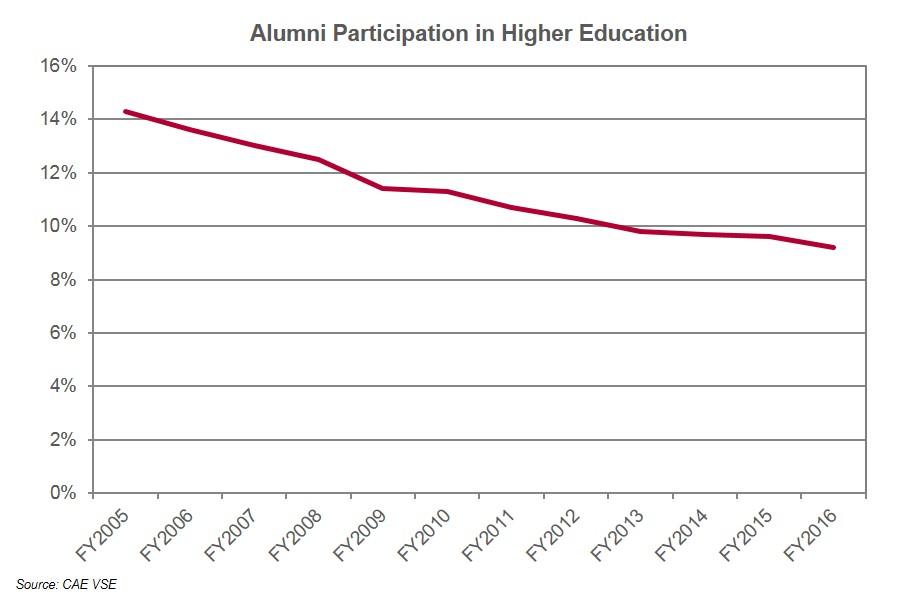When alumni ask to be taken off a contact list, what are they really saying?
“I don’t care about [school name] the way I used to.”
The problem is, colleges and universities don’t listen.
As a profession, higher education advancement is built on two ideas: (1) that all or most alumni have at least a little love for their alma mater, and (2) that institutions count on appealing to that heart-share for philanthropy.
A quick look at the nationwide decline in alumni giving and it’s clear that these two things are no longer true.
This six-part series on alumni identity has been about just that: providing and proving a new way forward for institutions to increase alumni fundraising outcomes.

Let’s recap what we’ve covered so far…
A graduate’s alumni identity is the degree to which their sense of self is attributed to their alma mater.
Graduates with high alumni identity are far more likely to be donors than graduates with low alumni identity
A graduate’s alumni identity is influenced most by:
- Volunteering for their alma mater
- Joining their alma mater’s official LinkedIn group
- Liking their alma mater’s official Facebook page
- Attending an alma mater-sponsored event
- Opening an e-newsletter from their alma mater
A graduate’s alumni identity IS NOT related to what they did in school (read: student activities), their age, class year, or how far they live from campus.
The path ahead is clear to some but hard to navigate for many because the well-worn ruts in the advancement road are comfortable and difficult to leave behind.

Here are three simple things you can do to integrate the principles of alumni identity into your advancement practice.
Reframe Your Audience
Not all alumni feel a deep sense of connection to their alma mater. Many never will and there is little any institution can do to change that. The majority of graduates may have pride or affinity for their college or university, but that is not the same as having an alumni self-identity. A high degree of alumni identity is the best indicator of a graduate’s likelihood to exhibit support behaviors (McDearmon 2011). Reframe your alumni audience to include only those graduates with moderate to high levels of alumni identity. Start by conducting an alumni identity assessment (get a sneak peek at the tool: score.alumniidentity.com).
Refine Engagement Towards Digital
Research has demonstrated that digital engagements exert equal or sometimes greater influence on a graduate’s alumni identity as compared to event attendance (Dillon, 2017). Second only to human resources, event strategies consume the largest portion of most operational budgets within advancement. Yet alumni event attendance (especially reunions) is in decline across higher education. Refine engagement strategies to give equal budgetary support to digital engagement strategies. Start by tackling these 10 best habits for successful digital engagement.
Refrain from Broad Strokes
Increasing the alumni identity of graduates requires targeted effort AND some wholesale change. The lessons of the pre-internet era that have informed much of current fundraising practice are woefully out of date. Cyclical engagement efforts are almost antithetical to the way alumni experience connection in the age of on-demand information. Refrain from relying on broad strokes when it comes to alumni marketing segmentation (i.e. age, class year, location). Start by avoiding these three massive myths in higher education fundraising.
This series began with a simple question (Are you missing advancement’s most important metric?) so it’s fitting to wrap up with one too.
What if colleges and universities understood engaged alumni the way retail brands know their best customers?
Alumni identity does that.
Read Dr. Jay Le Roux Dillon’s entire series on alumni identity.
Part 1: Are You Missing Advancement’s Most Important Metric?
Part 2: The Story Behind Giving Has Little to Do With 1s and 0s
Part 3: Digital Engagement ≥ Event Engagement? Yes.
Part 4: Meaningful Volunteer Experiences Are Best, But Far Too Few
Part 5: Data-driven Prospect Discovery Needs to Include Graduate Feelings of Connection
Part 6: Raising Alumni Identity Raises Dollars
Need more? Connect with the author:
LinkedIn.com/in/jayldillon
Twitter @jayldillon
alumniidentity.com
Dr. Jay Le Roux Dillon is a social scientist and higher education consultant with 14 years of progressive leadership experience in advancement. Jay’s research and consulting practice focus on broadening and measuring institutional value and impact among college and university alumni. He has served as Director of Alumni Engagement at the University of San Francisco and as Executive Director of Alumni Strategic Initiatives at UCLA. Jay is dedicated to improving philanthropy through data science in order to bring social justice and equity to education. He holds a doctorate in organization & leadership from USF and a master’s and bachelor’s degree in music from UCLA.